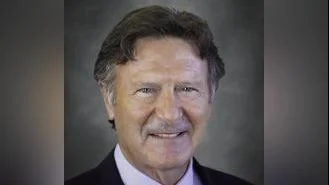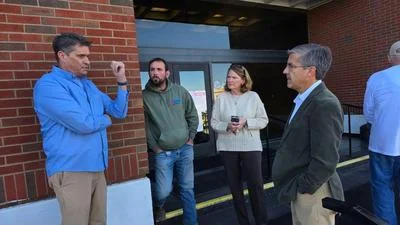Southern Illinois' Kyle Landon competes in the high jump in this undated photo. Landon took the silver medal at the U.S. Olympic Trials on July 10 in Eugene, Oregon. | SIU Media Services
Southern Illinois' Kyle Landon competes in the high jump in this undated photo. Landon took the silver medal at the U.S. Olympic Trials on July 10 in Eugene, Oregon. | SIU Media Services
That time nearly came July 10, when Southern Illinois' All-American high-jumper claimed the silver at the U.S. Olympic Trials in Eugene, Oregon. Landon cleared a personal-best height of 7 feet, 5 inches – just three-fourths of an inch below Olympic-qualifying standard, according to siusalukis.com. Landon was one of three competitors to clear that mark without a miss during the trials.
Landon had come close to that height during the 2016 outdoor season, when he cleared 7 feet, 2¼ inches or higher 10 times, according to siusalukis.com.
“I have had the potential to jump 7-5 all season,” Landon told Southeast Illinois News in an email interview. “I had attempted bars set at 7-5 or higher about 11 out of the 14 meets this season. I was always missing because of little mistakes, whether it was my approach, takeoff or flight. Finally, a few weeks before the Olympic Trials, Coach (Terry) VanLaningham and I realized it was about that time to clear the big bar. We had a great feeling going into the trials about being able to clear 7-5."
The Chester, Illinois, native was unable to clear a higher mark that day, however. The winner of the 14-man final was 2012 Olympic silver-medalist Erik Kynard, who was the only competitor to clear 7-6, according to OregonLive.com. Bradley Adkins of Texas Tech and Ricky Robertson of the University of Mississippi also made the team after previously clearing the Olympic standard.
Still, clearing 7-5 puts Landon in good company at Southern Illinois University. The school's athletic website says that only three other Salukis have cleared that height, and all of them were Olympians: Darrin Plab and Cameron Wright, who competed for the United States in 1992 and 1996, respectively; and Stephen Wray, who competed for the Bahamas in 1984.
At Eugene, the competition was held amid windy, drizzly conditions that provided even more of a challenge for the jumpers. But Landon credited his process for his strong showing despite the conditions.
“The keys to my success at the Olympic Trials were being able to maintain complete composure and staying relaxed,” he said. “Everything leading up to the meet had gone so great that all I had to do was execute. The jumps at the Olympic Trials felt the easiest of the season because I worked the process and trusted everything would work.”
One of the technical adjustments Landon and VanLaningham made ahead of the trials was to simplify Landon's jump approach by cutting off 30 feet. Landon called his old approach — which was part of his first-team All-American season and his continued dominance in the event in the Missouri Valley Conference — too inconsistent.
“I just have to get stronger and practice the approach more," he said. "Who knows how I would have jumped if I would have had this new approach all season."
Landon said he gained experience at Eugene that will help him not only in future Olympic Trials, but also in his upcoming final season at Southern Illinois.
“The biggest thing I learned would be that nothing is guaranteed," he said. "In order to achieve what you want, you have to be willing to do what it takes to get it. You have to stay humble and composed, and work the process. When I say work the process, I mean not try to get anywhere too fast. If you stay healthy and train smart, you can have a long career in track and that is paramount to reaching your full potential. With age comes strength and experience, and I have a good eight years or more left in me if I remain patient.”




 Alerts Sign-up
Alerts Sign-up